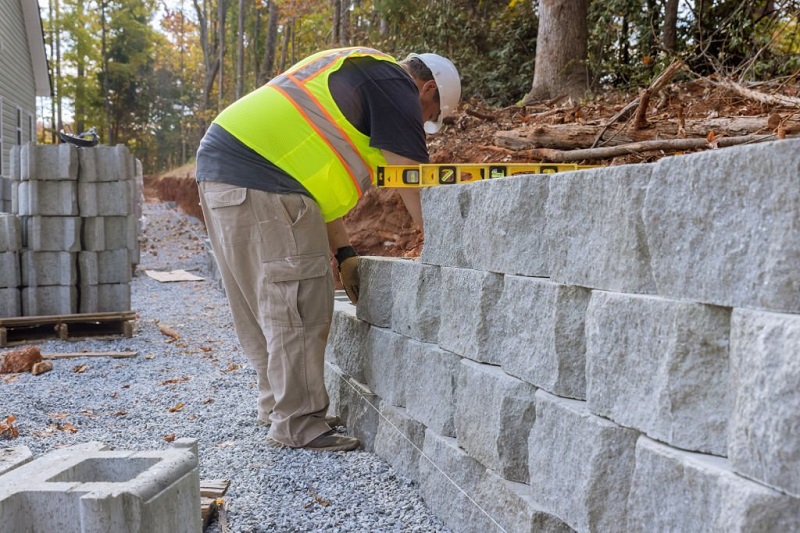Retaining walls are more than just a functional part of your property’s landscape. These structures serve a dual purpose: they prevent the erosion of your land and add a touch of beauty to your property. This article delves into how retaining walls accomplish these two crucial tasks and why you might want to consider installing one if you haven’t already.
1. What is a Retaining Wall?
A retaining wall is a structure designed to hold or retain soil behind it. It’s commonly used in landscapes where two different ground levels exist, and there’s a need to transition smoothly from one level to another. They are typically made of concrete, bricks, stone, wood, or even vinyl and come in a variety of designs to suit different property styles.
I. Definition and Function:
- Define a retaining wall as a structure designed to hold back soil and prevent erosion.
- Explain how it helps to create level surfaces on sloped landscapes.
- Highlight its ability to withstand lateral pressure and support vertical loads.
III. Structural Support:
- Highlight the primary function of retaining walls in providing structural support.
- Explain how they help to stabilize soil and prevent it from collapsing or sliding.
- Discuss their use in creating terraces or leveled areas for construction purposes.
V. Material Choices:
- Discuss various materials commonly used for retaining walls, including concrete, stone, timber, and brick.
- Explain the benefits and characteristics of each material, such as durability, aesthetics, and cost.
- Encourage readers to consider the design style, project requirements, and maintenance needs when choosing materials.
2.. Types of Retaining Walls
There are several types of retaining walls, each offering unique aesthetic and functional benefits. Some popular types include gravity walls, which rely on their weight to hold back the soil; cantilever walls, which are anchored at the base and use less material; and sheet piling walls, which are thin walls used for soft soils and tight spaces.
Choosing the right type of wall depends on your specific needs and preferences, the characteristics of your landscape, and the amount of space available. It’s always best to consult with a professional contractor to determine the most suitable option for your property.
I. Gravity Retaining Walls:
- Define gravity retaining walls as structures that rely on their own weight to resist soil pressure.
- Discuss the common materials used, such as concrete or stone blocks.
- Explain their suitability for low- to medium-height applications and their cost-effectiveness.
II. Cantilever Retaining Walls:
- Explain the concept of cantilever retaining walls, which utilize leverage and reinforced design.
- Discuss their construction process, including the use of a footing, stem, and base slab.
- Highlight their strength and suitability for medium- to high-height retaining wall needs.
III. Sheet Pile Retaining Walls:
- Introduce sheet pile retaining walls, which consist of interlocking steel, vinyl, or wood panels.
- Discuss their use in soft soil conditions or waterfront applications.
- Explain the installation process, which involves driving the sheet piles into the ground.
IV. Anchored Retaining Walls:
- Describe anchored retaining walls, which use cables or rods for additional support.
- Explain their construction, including the use of anchors embedded in the soil behind the wall.
- Discuss their effectiveness in managing high loads or challenging soil conditions.
V. Gabion Retaining Walls:
- Introduce gabion retaining walls, which use wire mesh cages filled with rocks or gravel.
- Discuss their flexibility, allowing for drainage and natural vegetation growth.
- Explain their suitability for erosion control and aesthetic appeal.
VI. Reinforced Soil Retaining Walls:
- Explain reinforced soil retaining walls, which combine soil and geosynthetic reinforcement.
- Discuss the benefits of this cost-effective and flexible solution.
- Highlight their applications in various soil conditions and heights.
VII. Natural Stone Retaining Walls:
- Discuss the use of natural stone for retaining walls, such as stacked stone or boulder walls.
- Explain their aesthetic appeal and durability.
- Highlight their suitability for blending with natural surroundings or creating a rustic look.
VIII. Modular Block Retaining Walls:
- Introduce modular block retaining walls, which utilize precast concrete blocks.
- Discuss their ease of installation and versatility in design.
- Highlight their suitability for both residential and commercial applications.
3. How Retaining Walls Prevent Erosion
Retaining walls play a crucial role in erosion prevention. Erosion occurs when natural elements like water and wind gradually wear away soil or rock. This can lead to unstable slopes and potentially damage your property. Retaining walls counteract this by holding the soil in place and reducing the slope’s angle, making it harder for erosion to occur.
Moreover, they help control runoff by reducing the speed at which water drains from the land. Some retaining walls even incorporate drainage systems to direct water away from the soil. This functionality is especially important in areas prone to heavy rainfall or flooding, where large volumes of water can quickly erode the landscape.
4. How Retaining Walls Enhance Property Aesthetics
Aside from their functional benefits, retaining walls can greatly enhance the aesthetics of your property. They provide an opportunity to introduce texture and color into your landscape, contributing to a more appealing and visually interesting space.
Retaining walls can also create usable flat areas on sloped properties, which can be used for planting gardens, installing patios, or creating outdoor living spaces. Additionally, they can serve as a focal point in your landscape design, adding value and character to your property.
Conclusion
In conclusion, retaining walls offer a practical and attractive solution for managing erosion and enhancing your property’s aesthetics. Whether you’re dealing with a sloped landscape, erosion problems, or simply want to upgrade your property’s look, retaining walls can provide a versatile and durable solution. By understanding their functions and different types, you can make an informed decision that will ultimately lead to improved property value and enjoyment of your outdoor space.

